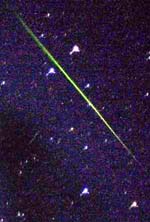|
|
| Last updated at: (Beijing Time) Monday, November 19, 2001 |
Rendezvous with Leonid Meteor Shower |
 From 1:30 Monday morning, Leonid meteor shower began to appear in the sky, with an internal of about 10 seconds. Thousands of Beijing people had been ready to view the miracle. From 1:30 Monday morning, Leonid meteor shower began to appear in the sky, with an internal of about 10 seconds. Thousands of Beijing people had been ready to view the miracle.
|
|
 |
|
|
 |
|

Leonid Meteor Streak across the Sky
Tens of thousands of stargazers across China watched the Leonid meteor storm early Monday morning.
In Beijing, a crowd gathered in open ground near Yanqi Lake in the suburban Huairou County, joyfully cheering when passing meteors lit up the sky around 00:40 hours Monday.
Zhang Xuekui, deputy head of the Beijing Planetarium, explained that as the first quarter moon set in the latter half of the night, there was less disturbance from a strong moonlight, so stargazers could clearly watch the meteor storm.
Beijing Planetarium organized tens of thousands of stargazers to watch the meteor storm from places including Yanqi Lake and the Great Wall.

Rendezvous with Leonic Meteor Showers
The Leonid meteor storm, which occurs every 33 years, was the first to be seen in China this century.
Li Guangyu, a research fellow who watched the meteor storm from the Xuyi Station at the Chinese Academy of Sciences' Purple Mountain Observatory in east China's Jiangsu Province, reported that a strong Leonid meteor storm was observed around 01:30 hours Monday morning, with the biggest number of passing meteors being estimated at over 10,000 per hour.
"In the early stage of the storm, the majority were bolides -- the brightest meteors which outstrip the even brightness of a full moon," said Li, "but after 02:30 hours, dark meteors began to increase and gradually becoming dominant."
The Leonid meteor storm last until 05:00 hours.
Xu Pinxin, a Chinese meteor rain specialist, watched the Leonid meteor storm for more than two hours this morning from the Purple Mountain Observatory based in Nanjing City, capital of Jiangsu.
"Observations confirmed astronomical scientists' forecasts about the time and the intensity of the Leonid meteor," said Xu, declaring accurate forecasting the major breakthrough in astronomical research.
According to Xu, four meteor storms occurred in the 20th century, but were not seen in China. Xu believes that successfully observing Leonid meteor storms from China would be of significance in promoting astronomical research in the country and for popularizing knowledge of meteor storms.
Leonid meteorsLeonid meteors -- so called because they appear to come from the same part of the sky as the constellation Leo -- fall to Earth each November.
Astronomers had predicted that this year's show would be exceptionally dramatic, with up to 30 shooting stars streaking across the American sky each minute at the storm's height and perhaps 100 a minute over eastern Asia and Australia. During a normal year, Earth encounters 10-15 Leonid meteors an hour.
This year is special because Earth will travel close to three paths of cosmic dust and debris left by comet Tempel-Tuttle's previous trips around the sun.
The comet orbits the sun every 33.25 years and takes a slightly different path each time; this year Earth was near dust trails left in 1699, 1767 and 1866.
The last major Leonid shower occurred in 1966, when stargazers counted as many as 150,000 meteors per hour. Astronomers expect another such shower in 2099.
|
|
|
|
|